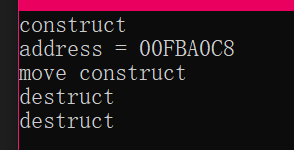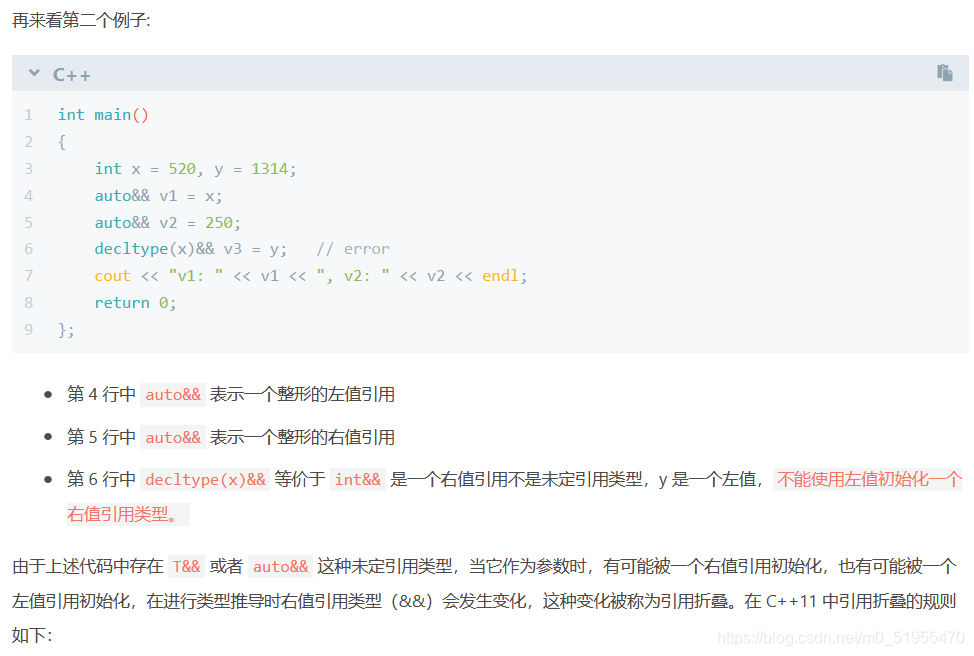
代码如下:
#include <iostream>
using namespace std;int main()
{//左值int num = 9;//左值引用int &a = num;//右值const int N = 5;//右值引用int && b = 8;//常量左值引用const int &c = num;//常量右值引用const int &&d = 6;//const int &&d = b; error//int && f = b; error//右值引用给常量的左值引用初始化const int &a = b;//常量右值引用给常量的右值引用初始化const int &aa = d;}
右值引用的作用以及使用:

代码如下:
#include <iostream>
using namespace std;class Test
{
public:Test() :m_num(new int(100)){cout << "construct" << endl;cout << "address = " << m_num << endl;}Test(const Test & a) :m_num(new int(*a.m_num)){cout << "copy construct" << endl;}~Test(){cout << "destruct" << endl;delete m_num;}public:int *m_num;
};Test getobj()
{Test t;return t;
}int main()
{Test t = getobj();return 0;
}
测试结果:

代码如下:
#include <iostream>
using namespace std;class Test
{
public:Test() :m_num(new int(100)){cout << "construct" << endl;cout << "address = " << m_num << endl;}Test(const Test & a) :m_num(new int(*a.m_num)){cout << "copy construct" << endl;}//有右值引用的构造函数称为移动构造函数//移动构造函数 -> 复用其他对象中的资源(堆内存)//m_num 浅拷贝Test(Test && a) :m_num(a.m_num){a.m_num = nullptr;cout << "move construct" << endl;}~Test(){cout << "destruct" << endl;delete m_num;}public:int *m_num;
};Test getobj()
{Test t;return t;
}int main()
{Test t = getobj();//直接赋值return 0;
}
测试结果:

因为getobj()返回的是临时变量,所以程序优先调用移动构造函数,如果返回的不是临时对象,就会调用拷贝构造函数。
通过右值引用赋值:
代码如下:
int main()
{Test && t1 = getobj();cout <<"address = "<< t1.m_num << endl;return 0;
}
测试结果:

不管是直接进行赋值,还是右值引用赋值,都要求右侧的对象是一个临时对象,才会调用移动构造函数。
如果没有移动构造函数,它会调用拷贝构造函数。
如果没有移动构造函数,使用右值引用初始化要求更高一点。
要求右侧是一个临时的不能取地址的对象。
代码如下:
Test getobj()
{return Test();
}int main()
{Test && t2 = getobj();cout <<"address = "<< t2.m_num << endl;return 0;
}
测试结果:


代码如下:
Test&& getobj()//将亡值
{return Test();
}int main()
{Test && t2 = getobj();cout <<"address = "<< t2.m_num << endl;return 0;
}
测试结果:

&&的特性:









右值引用被推导或被传递之后对应的就是一个左值或者右值。
以上图片来自下面链接:
https://subingwen.cn/cpp/rvalue-reference/



![[C++11]move资源的转移](http://pic.xiahunao.cn/[C++11]move资源的转移)
 v4.2)

)

![[C++11]forward完美转发](http://pic.xiahunao.cn/[C++11]forward完美转发)

)


![[C++11]智能指针简单介绍](http://pic.xiahunao.cn/[C++11]智能指针简单介绍)

...)
![[C++11]shared_ptr使用的注意事项(内存被重复析构,内存泄漏问题)](http://pic.xiahunao.cn/[C++11]shared_ptr使用的注意事项(内存被重复析构,内存泄漏问题))

)
![[C++11]shared_ptr共享智能指针的初始化与使用](http://pic.xiahunao.cn/[C++11]shared_ptr共享智能指针的初始化与使用)